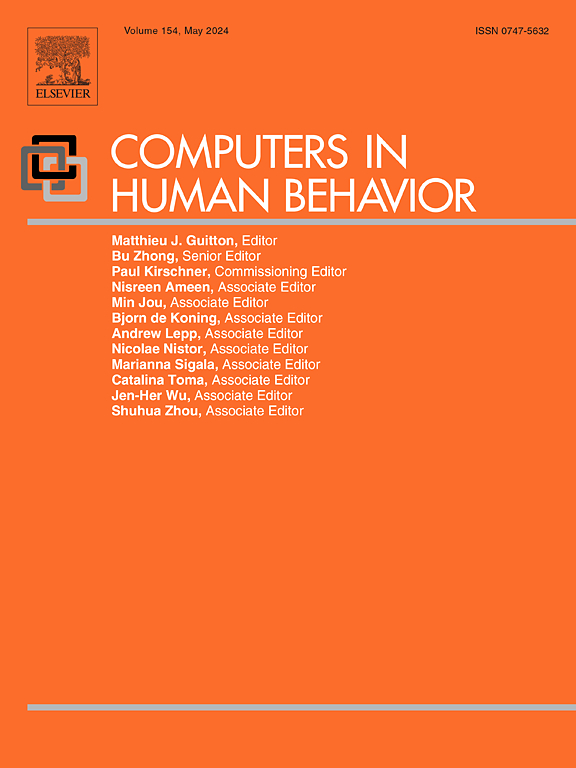数字字符的物理特征影响群体分类和情感状态的识别
IF 9
1区 心理学
Q1 PSYCHOLOGY, EXPERIMENTAL
引用次数: 0
摘要
在加拿大这样的多元化国家,社会群体分类和情感状态识别中的种族偏见持续存在,可能会影响与少数群体的互动。随着数字角色(DCs)在各种环境中的使用越来越多,探索这些偏见是否会延伸到虚拟环境中以减轻这些问题变得至关重要。本研究创建并验证了 16 个逼真的 DC,以考察个人如何感知他们的身体特征,同时调查种族偏见的影响。来自多数群体(白人)的 112 名参与者完成了一项由两部分组成的在线任务,在这项任务中,他们被要求感知这 16 个 DC 的 1)中性状态下的身体特征,如表型(黑人、白人、拉美人或亚洲人)、性别、年龄和逼真度,以及 2)DC 所表达的四种情感状态(疼痛、愤怒、悲伤或中性),以及与之相关的成分(强度、价值和唤醒)。参与者对白人直流电的分类比亚裔和拉美裔直流电更准确,比拉美裔直流电更快。与其他两个少数群体(亚裔和黑人)相比,后者的分类准确度和速度都较低。此外,在所有其他情感状态和表型群体中,亚裔 DC 的愤怒面部表情识别率最低。因此,在有多种表型的情况下,自身表型偏差会减弱,因为非常相似或非常不同的身体特征有助于有效的分类。这项研究有助于人们更深入地了解在虚拟环境中如何感知不同的表型群体,并介绍了可用于人机交互研究的新创数字角色。本文章由计算机程序翻译,如有差异,请以英文原文为准。
Physical characteristics of digital characters influence group categorization and recognition of affective states
Ethnic bias in social group categorization and recognition of affective states persist in diverse countries like Canada, potentially affecting interactions with minority groups. With the growing use of digital characters (DCs) across various settings, it becomes crucial to explore whether these biases extend to virtual environments to mitigate these issues. This study created and validated 16 realistic DCs to examine how individuals perceive their physical characteristics while investigating the effects of ethnic biases. 112 participants from the majority group (White) completed a two-part online task in which they were asked to perceive in the 16 DCs 1) physical attributes in a neutral state such as phenotype (Black, White, Latin American, or Asian), gender, age, and realism, and 2) four affective states expressed by DCs (pain, anger, sadness, or neutral), as well as components associated with them (intensity, valence, and arousal). Participants categorized White DCs more accurately than Asian and Latin American DCs, and faster than Latin American DCs. The latter were also categorized less accurately and slower than the two other minority groups (Asian and Black DCs). Furthermore, the anger facial expression on Asian DCs was the least recognized among all other affective states and phenotypic groups. Thus, an attenuated own-phenotype bias emerged in contexts with multiple phenotypes, where very similar or very different physical characteristics contribute to efficient categorization. This study contributes to a finer understanding of how different phenotypic groups are perceived in virtual environments and introduces newly created digital characters that could be used for studies in human-agent interactions.
求助全文
通过发布文献求助,成功后即可免费获取论文全文。
去求助
来源期刊

Computers in Human Behavior
Multiple-
CiteScore
19.10
自引率
4.00%
发文量
381
审稿时长
40 days
期刊介绍:
Computers in Human Behavior is a scholarly journal that explores the psychological aspects of computer use. It covers original theoretical works, research reports, literature reviews, and software and book reviews. The journal examines both the use of computers in psychology, psychiatry, and related fields, and the psychological impact of computer use on individuals, groups, and society. Articles discuss topics such as professional practice, training, research, human development, learning, cognition, personality, and social interactions. It focuses on human interactions with computers, considering the computer as a medium through which human behaviors are shaped and expressed. Professionals interested in the psychological aspects of computer use will find this journal valuable, even with limited knowledge of computers.
 求助内容:
求助内容: 应助结果提醒方式:
应助结果提醒方式:


